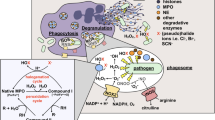Abstract
The reaction of sulfhydryl groups in human serum ablumin with bacteriostatic and hypotensive nitrosating agents such as sodium nitroprusside and sodium nitrite has been examined. The low reactivity of sodium nitroprusside to sulfhydryl groups in albumin has been observed and the sterical inaccessibility of this agent to the site which sulfhydryl group resides was implicated. The reaction of sodium nitrite with albumin was highly influenced by pH and little reactivity was observed at physiological pH. On the other hand, the reaction between albumin and S-nitrosoglutathione, an intermediate induced from the reaction of glutathione and nitrosating agents, resulted in the rapid decrease of free sulfhydryl groups in albumin. S-Nitrosylation of the sulfhydryl group by S-nitrosoglutathione and the subsequent production of mixed disulfide is the probable route of modification. In the physiological system, S-nitrosoglutathione may act as an active intermediate in expressing reactivity of nitrosating agents to sulfhydryl groups in albumin.
Similar content being viewed by others
Literature cited
Brandwein, H. J., Lewicki, J. A. and Murad, F., Reversible inactivation of guanylate cyclase by mixed disulfide formation.J. Biol. Chem., 256, 2985 (1981).
Braughler, J. M., Mittial, C. K. and Murad, F., Effects of thiols, sugars, and proteins on nitric oxide activation of guanylate cyclase.J. Biol. Chem., 254, 12450 (1989).
Craven, P. A. and DeRubertis, F. R., Electron spin resonace study of the role of NO-catalase to nitrosoguanidine, nitric oxide, and related activators by heme and heme proteins.J. Biol. Chem., 253, 8433 (1978).
Ellman, G. L., Tissue sulfhydryl groups.Arch. Biochem. Biophys., 82, 70 (1959).
Furchgott, R. F. and Vanhoutte, P. M., Endothelium-derived relaxing and contracting factors.FASEB J., 3, 31 (1989).
Genest, J., Kuchel, O., Hamet, P. and Cantin, M.,Hypertension; physiopathology and treatment, McGraw-Hill, New York, 1983, pp. 1122–1127.
Hansen, J. N. and Levine, R. A., Effect of some inhibitors derived from nitrite on macromolecular synthesis inBacillus cereus.Appl. Microbiol., 30, 62 (1975).
Incze, K., Farkas, J., Mihalyl, V. and Zukal, E., Antibacterial effect of cysteinenitrosothiol and possible precursors thereof.Appl. Microbiol., 27, 202 (1974).
Ignarro, L. J. and Gruetter, C. A., Requirements of thiols for activation of coronary arterial guanylate cyclase by glyceryl trinitrate and sodium nitrite.Biochim. Biophys. Acta, 631, 221 (1980).
Ignarro, L. J., Edward, J. C., Gruetter, D. Y., Barry, B. K. and Gruetter, C. A., Possible involvement of S-nitrosothiols in the activation of guanylate cyclase by nitroso compounds.FEBS Lett., 11, 275 (1980).
Ignarro, L. J., Lippton, H., Edward, J. C., Baricos, W. H., Hyman, A. L., Kadowitz, P. J. and Gruetter, C. A., Mechanism of vascular smooth muscle relaxation by organic nitrates, nitrites, nitroprusside and nitric oxide.J. Pharmacol. Exp. Ther., 218, 739 (1981).
Ignarro, L. J., Endothelium-derived nitric oxide: actions and properties.FASEB J., 3, 31 (1989).
Johnson, M. D. and Wilkins, R. P., Kinetics of the primary interaction of pentacyanonitrosylferrate (2-) (nitroprusside) with aliphatic thiols.Inorg. Chem., 23, 231 (1984).
Means, G. E. and Park, J.-W., Nitrosothiols as hypotensive agents.United States Patent, #4,990,719 (1990).
Mittal, C. K. and Murad, F., Activation of guanylate cyclase by superoxide dismutase and hydroxyl radical.Proc. Natl. Acad. Sci. USA, 73, 4630 (1977).
Morris, S. L. and Hansen, J. N., Inhibition ofBacillus cereus spore outgrowth by covalent modification of a sulfhydryl group by nitrosothiol and iodoacetate.J. Bacteriol., 148, 465 (1981).
Morris, S. L., Walsh, R. C. and Hansen, J. N., Identification and characterization of some bacterial membrane sulfhydryl groups which are targets of bacteriostatic and antibiotic action.J. Biol. Chem., 259, 13590 (1984).
Myers, P. R., Minor, R. L. Jr., Bates, J. N. and Harrison, D. G., Vasorelaxant properties of the endothelium-derived relaxing factor more closely resemble S-nitrosocystein than nitric oxide.Nature, 345, 161 (1990).
Needleman, P., Akschik, B. and Johnson, E. M. Jr., Sulfhydryl requirement for relaxation of vascular smooth muscle.J. Pharmacol. Exp. Ther., 187, 324 (1973).
Park, J.-W., Reaction of S-nitrosoglutathione with sulfhydryl groups in protein.Biochem. Biophys. Res. Commun., 152, 916 (1988).
Saville, B., A scheme for the colorimetric determination of microgram amounts of thiols.Analyst, 83, 670 (1958).
Stamler, J. S., Simon, D. I., Osbome, J. A., Mullins, M. E., Jaraki, O., Michel, T., Singel, D. J. and Loscalzo, J., S-Nitrosylation of proteins with nitric oxide: synthesis and characterization of biologically active compounds.Proc. Natl. Acad. Sci. USA, 89, 444 (1992).
Wilson, J. M., Wu, D., Motiu-DeGrood, R. and Hupe, D. J., A spectrophotometric method for studying the rates of reaction disulfides with protein thiol groups applied to bovine serum albumin.J. Amer. Chem. Soc., 102, 360 (1980).
Author information
Authors and Affiliations
Rights and permissions
About this article
Cite this article
Park, JW. S-Nitrosylation of sulfhydryl groups in albumin by nitrosating agents. Arch. Pharm. Res. 16, 1–5 (1993). https://doi.org/10.1007/BF02974119
Received:
Issue Date:
DOI: https://doi.org/10.1007/BF02974119




